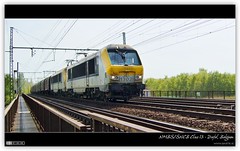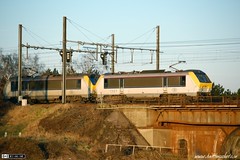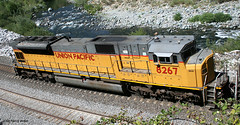Jan
24
Pondering US -v- EU Locomotives
Filed Under 42 (Life the Universe & Everything) on January 24, 2011 at 2:45 pm
This all started with a really childish and really stupid comment on Flickr by a young American rail fan:
Probably because the cabs on American locomotives aren’t ugly as the atrocious things that pass for locomotives in Europe.
The sheer childishness of it all put me off replying, but it did start me thinking, apart from the very obvious difference in style, what are the real differences between our locomotives?
Starting from just an Irish point of view, the biggest difference is scale. Ireland is small, so, we have no use for locomotives that are optimised for very long distances. In the US railway lines can be thousands of miles long, while in Ireland the longest line we have is Dublin to Cork which comes in at just under 170 miles. The next obvious difference is fleet size. Irish Rail is too small to operate lots of different classes of locomotive at once. At the moment we basically have two classes of locomotive in use, the older 071 Class and the newer 201 Class. We do have a few other older locos still in use, but they’re generally doing menial tasks rather than pulling trains. It wouldn’t be practical in a small fleet to have highly specialised locos, they need to be able to do both passenger services at a high speed, and goods duties where they can pull a decent load. Finally, our rail network in Ireland is dominated by passenger services, and not by freight services, we do have freight services, but they share the same tracks with the passenger services. This means ‘slow and steady’ is not option for our freight trains, they need to be able to attain decent speeds so they don’t hold up the passenger traffic.
Given those differences, it’s probably not surprising that Irish locomotives are different to US locomotives. If we expand it out to look at Europe as a whole, the situation is much the same, with the exception that the larger countries can afford to have more specialised fleets than Irish Rail can.
Before looking into the numbers, I expected to find that US locomotives were more powerful that European ones, but that’s not at all what I found. The difference is not raw power, but how that power is used. The key is tractive effort, i.e. the total pulling force the locomotive can exert. There are lots of factors that affect tractive effort, but two big ones are the weight of the locomotive, and the gearing of the motors. The friction between the wheels and the track is determined by the weight pushing down on each axel. The heavier the locomotive, the more power it can put out before the wheels begin to slip on the track. There is of course a down-side to a heavy locomotive, they need more power to actually move themselves, and the heavier a loco is, the slower it is. The second factor is the gearing, small ratios allow more tractive effort, but, at the cost of speed. So, a heavy loco with small gears can pull a much heavier load, but at a much slower speed than a lighter locomotive with bigger gear ratios with the identical engine power.
From an Irish point of view, our most powerful locomotives are the 201 class, they have an engine that puts out 3,200 horse power, with a maximum speed of 102 miles per hour. This makes the 201s very average and very general purpose locos. 100mph is fast enough for express inter-city passenger services, especially when the longest route is 170 miles, but they still have enough tractive effort to pull freight trains too. At 3,200hp the engine is neither exceptionally big nor exceptionally small. It’s a middle of the road engine, comparable in power to the popular SDP40s in the US.
Turning to Europe things get more interesting. The Belgian Class 13 electric locos look quite small, quite quaint, and not all that powerful:
They certainly look a lot smaller than the US SD90MACs:
You’d be inclined to assume that the US loco has FAR more raw power than that little Belgian one, but you’d be wrong. The Belgian loco is actually more powerful, having 7,000hp, while the US loco has ‘just’ 6,250hp. So the Belgian loco can pull a heavier load? Nope, the Belgian loco has a tractive effort of ‘just’ 288kN, while the US loco has a tractive effort of 890kN. How can that be? The key difference is the weight and gearing of the locos, the Class 13 weighs just 90t, while the SD90MAC weighs a whopping 188t. Similarly, the Belgian Class 13 is geared for speed as well as tractive effort, so it gets a maximum speed of 200km/h (about 125mph), while the American MAC only gets a max of a little under 130km/h (80mph). The Belgian Class 13s are used both for intercity and international express trains, as well as for freight services, but they’re used to pull less freight at a higher speed so as not to hold up passenger trains, while the US MACs are designed to pull very very long freight trains slowly.
Which is best? That’s a stupid question. There’s no such thing as an absolute best locomotive, you can only look at them in context. Would I want to take an Irish Rail Class 201 or a Belgian Class 13 to America to haul freight from New York to LA, heck no! For a start, the US freight lines are not electrified, so the class 13 could never even start! And the Irish Rail class 201 wouldn’t have enough tractive effort to even get a US freight train moving! But, if you flip things around, would a US MAC do better on the run from Dublin to Cork? Heck no! It would be too slow and too heavy! Similarly, it would be a total disaster on an international passenger run from Antwerp to Luxembourg! So, unsurprisingly, US locos have been designed and built for US railways, and European Locos have been optimised for European railways, and neither could do the other’s job well. Both sets of locos have very comparable raw power outputs, but they use that power very differently, choosing very different trade-offs between weight, speed, and tractive power.
The other question is looks. Clearly the styling is very different. European locos tend to be smaller, lighter, and more streamlined, while US locos tend to be massive, heavy, and blocky in design. That’s not surprising though, when you’re pulling a heavy freight train at 20mph, wind resistance is just not a big deal, but when you’re speeding along at 200kph with an express train, it’s a massive factor. As to which looks better, that’s purely a matter of personal taste. I can see the beauty in both myself.











Having ridden trains in the US they are indeed monsters. At the time I assumed it was part of that “Everything’s bigger” attitude, then I figured it was because they go longer distances. I had no idea there were so many trade-offs involved though. It sounds as complex as aeronautical engineering!
And personally I prefer sleek and sexy Europeans.
I was amazed by US railways, I lost count of the number of 1000m long freight trains we saw on a drive from El Paso to San Diego last year. I can’ being to imagine how much load they were pulling.
When I was in Santa Fe the railyard there is both a commuter railyard and a drinking/nightlife area. Their commuter train looks quite retro, and even has a big road runner painted on the side 🙂
http://en.wikipedia.org/wiki/New_Mexico_Rail_Runner_Express
My favourite train is the one below, the Shinkansen 500. Oh, and its duck billed sibling the 700 🙂
http://en.wikipedia.org/wiki/500_Series_Shinkansen
http://en.wikipedia.org/wiki/700_Series_Shinkansen
For the train treat of a lifetime, I’d recommend getting a Japan rail pass and going there for a couple of weeks.
Interesting article, Bart. New Zealand’s railways are different again. Our longest line is 681 km (423 M) but traverses some very challenging terrain, as do most of the lines. Starting and ending at sea level it reaches an elevation of 832m near the middle and in one of NZ’s greatest feats of engineering, the Raurimu Spiral (http://en.wikipedia.org/wiki/Raurimu_Spiral), rises 132m in a 2km distance as the crow flies. Our most powerful locomotive is electric, runs only on (part of) this line and outputs 4,000 hp, though I cannot find any tractive effort figures. Our most powerful diesel electric is brand new (there’s only 1 in the country so far) at 3,600 hp. In all the fleet is comprised of about 3 mainline diesel electrics, the pure electric mainline and 3 shunting types along with a smattering of other types. One of our other lines crosses a mountain range with the aid of a 1 in 33 grade, 8.5km (5.3 M) tunnel. It used to be electrified but now they run modified diesel electrics through it. Mainly used for getting coal out to port, it is also one of the world’s top scenic runs.
Thanks everyone for the great comments!
John – that road runner is bloody cool! I really think that’s a great idea to revive people’s love of trains – make them fun again! I purposely didn’t mention railcars in this post, because they’re a whole different kettle of fish – and it’s just mean to compare American railcars to the TGV or the Shinkansen 🙂 As was made clear by the mockery of Obama’s proposals to fund high-speed rail, America as a nation is just not in that game.
Allister – that Raurimu spiral is just cool! I found this great video of it on YouTube: http://www.youtube.com/watch?v=OKuHYeeVwLg&feature=related
It reminds me of the Tehachapi Loop in the states. I’ll tell you something though – if I ever make it over to NZ, I’m taking the Overlander!
Bart.
I’ve never travelled the North Island Main Trunk in daylight, but my parents did it recently and were disappointed because all the great engineering was beneath them and therefore not visible from the train! I do know a couple of spots on the main highway where you can see some viaducts. I’m sure more can be found by going off the beaten track a bit. As an indicator of the current place rail holds in New Zealand, the Overlander almost ceased operations a couple of years ago. We’re still a nation obsessed with trucks for some reason.
Interesting article and you are right. But you forget one thing about the tractive effort. It also about how many axles a loco got. For example, if the Belgian Class 13 as mentioned in your article would have 6 axles instead of 4, it would have a higher tractive effort.
Thanks for the extra info F de Graaf!
I guess the more area you have touching the rails the more friction there is, and the harder it will be for the wheels to slip. But – is there not also a counter-acting effect? The more wheels you have down, the more the weight is spread out, so the less downward force you get on each wheel – hence each wheel will slip more easily? I guess the question is which effect is the most significant?
Bart.
Hi Bart,
I think you make it a bit too complicated. In my opinion the more axles you got (to a certain number of course) the more power the engine can put on the tracks.
Myself I drive the 6 axle Class 66 and the 4 axle BR 189. The first got 3,300 bhp, the last 6,000 bhp using 1,500 volt dc, 6,500 bhp at 3,000 volt dc and 9,000 bhp at 9,000 bhp.
Although more powerfull, obviously, the Br 189 slips very easily, even when dry. The Class however, never slips even when pulling throttle and even when standing on a slope.
Florijn
Hello Bart,
Interesting article and comments. I thought I might offer some observations:
Gearing does not directly affect the maximum load that can be hauled – unless the loco is so highly geared for high speed that the load has to be reduced at low speeds, so as not to overload the traction motors. Electric motors can exert high torque at low revs, it depends on how heavy duty they are as to how long they can do it for. High speed motors are preferably lighter, so are usually lighter duty. Still, modern AC traction motors can have quite a wide speed/traction range.
The number of axles makes no difference at all to adhesion. It is governed purely by the weight on the driving wheels. High speed locos tend to have lighter axle loads to be kinder to the track, while the USA, with heavy track, has high axle loads. High axle loads means less axles for the same weight and tractive effort, which reduces locomotive capital and maintenance costs.
Finally, besides weight, the second major factor affecting tractive effort is the adhesion (wheel slip) control system. Modern freight locos have electronic wheel creep systems, which use radar to compare actual speed with the speed each axle is turning. The control computer then finely manages the power to each axle to limit axle speed to slightly faster than actual speed – this condition is called “wheel creep”). This achieves the highest possible adhesion and so the highest tractive effort. Compared to 1950s and 1960s locomotives, current freight locos, with AC induction motors and advanced wheel creep control, can be scheduled to haul double the loads for the same weight of locomotive!
The electric locomotives in US are same as electric in the EU. The locos used for commercial freight rail in US are different due to their main use.
Funny to once more experience how public emotions about looks of traction guided answers. Have just been writing about the RENFE 278 and the NS 1200 and how they were developed from the Pennsylvania Railroad post-war electric test locomotives E2c and E3b. Adhesion from heavy weight and a lot of axles is far better used for freight in the USA, where in Europe and Japan traction control electronics play a big role in this line of work and this is where notably the class 278 Panchorgues in Spain had a problem. On the other side: remember the Amtrak E60 and SPD40F derailments to see how US builders got it desperately wrong and turned to European traction manufacturers for the Northeast Corridor services. Indeed: the demands for either speed or heavy haul specify what a loco will do, it can’t do both.